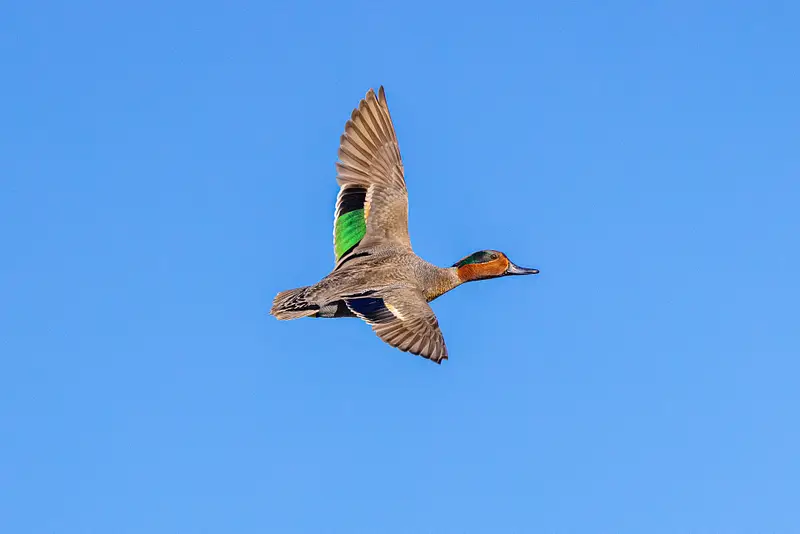About Green-Winged Teal
The Green-winged Teal (Anas crecca) is one of three North American species of teal and holds the distinction of being the smallest duck species on the continent, often weighing as little as 6 ounces. Despite their small size, these birds are renowned for their agility and speed, making them a favorite among birdwatchers and hunters alike. Green-winged Teal are highly migratory, with an impressive range that spans from the northern reaches of North America to the warmer climates of Central America during the winter months. These birds are also known for their early migration, often being one of the first duck species to head south as the seasons change.
To see the tracks of 16 Green-winged Teal head over to our duck map!

Identification
Green-winged Teal are easily recognizable by their small size and distinctive markings. Males have a striking iridescent green patch extending from the eye to the back of the head, contrasting with a chestnut-colored head. They also have a vertical white stripe on their side and a pale, speckled breast. Females are mottled brown with a subtle green wing patch, which can be seen in flight.
Breeding
Green-winged Teal typically breed in the northern prairies and boreal forests, preferring shallow wetlands with ample vegetation. The female constructs a nest on the ground, usually concealed by dense grasses or shrubs. She lays a clutch of six to ten eggs and is solely responsible for incubation and rearing the ducklings.
Behavior
Green-winged Teal are social birds that often form large flocks during migration and wintering periods. As dabbling ducks, they feed by tipping forward in shallow water to forage for seeds, aquatic vegetation, and small invertebrates. Their rapid flight and maneuverability make them a challenging target for hunters.
Habitat
During the breeding season, Green-winged Teal inhabit shallow ponds, marshes, and wetlands in the northern prairies and boreal forests. In the winter, they can be found in a variety of wetland habitats, including estuaries, coastal marshes, and flooded fields. Their adaptability to different environments allows them to thrive across a wide range of habitats throughout their migratory range.
Migration
Green-winged Teal are highly migratory, with breeding grounds primarily in the northern regions of North America, including Alaska and Canada. They migrate southward for the winter, traveling to the southern United States, Mexico, and even as far as Central America. These long-distance migrants often utilize major flyways such as the Pacific, Central, and Mississippi Flyways.
No Data Found
How many days tracked
Lorem ipsum dolor sit amet, consectetur adipiscing elit. Ut elit tellus, luctus nec ullamcorper mattis, pulvinar dapibus leo.
Where are they now?
Lorem ipsum dolor sit amet, consectetur adipiscing elit. Ut elit tellus, luctus nec ullamcorper mattis, pulvinar dapibus leo.
No Data Found
No Data Found
Total Number of Data Points for Green-Winged Teal
Lorem ipsum dolor sit amet, consectetur adipiscing elit. Ut elit tellus, luctus nec ullamcorper mattis, pulvinar dapibus leo.
Start and End Date Tracking of Green-Winged Teal
Lorem ipsum dolor sit amet, consectetur adipiscing elit. Ut elit tellus, luctus nec ullamcorper mattis, pulvinar dapibus leo.
No Data Found
Overall Data from the Center
This is historical data from various sources. This data is available in its full form on our Duck Map in an easily visualizable format.
